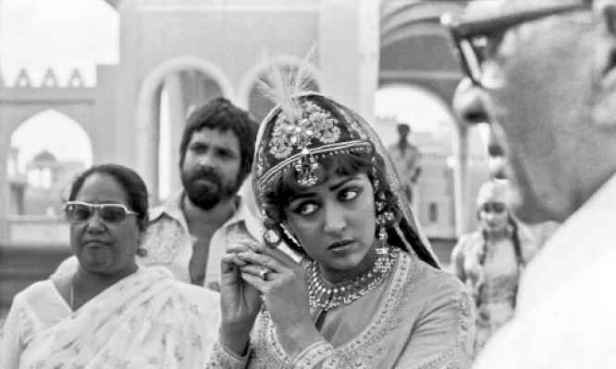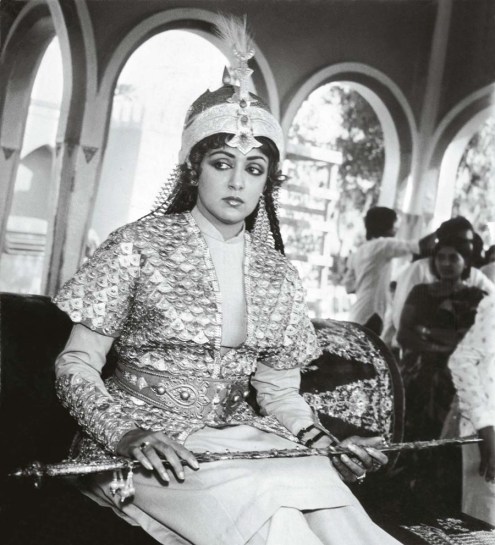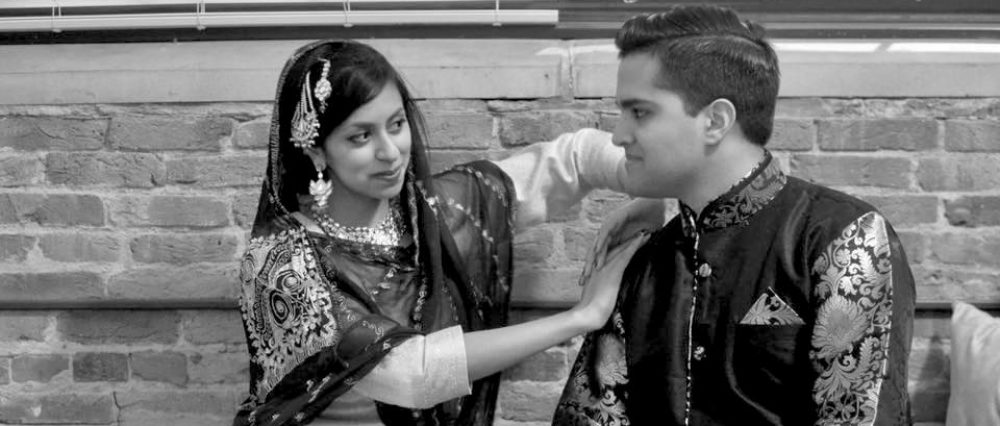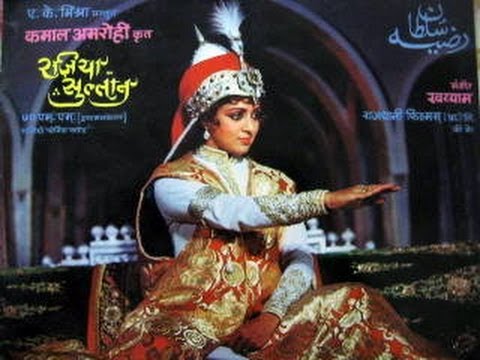As many of our readers may already be aware, today marks the 86th birthday of melody queen Lata Mangeshkar. In commemoration of this special day, we would like to present the lyrics and English translation to one of the most exquisitely beautiful songs sung by the Nightingale of India during her long and illustrious career: ai dil-e-naadaa.n from Razia Sultan (1983).
Directed by Kamal Amrohi (of Mahal and Pakeezah fame), Razia Sultan narrates the story of the only woman to ascend the throne of Delhi and her alleged love affair with Abyssinian slave-turned-warrior Jaml-ud-Din Yaqut. Hema Malini stars in the title role, while her real-life beau Dharmendra plays the role of her love interest Yaqut. When Sultan Altamash decides that his beloved daughter Razia shall be the successor to his throne instead of his trouble-making son Ferozshah, the kingdom erupts in an uproar over the possibility of being ruled by a woman. After her father’s passing, Razia proves herself to be a compassionate and brave ruler who leads with an eye toward justice like her late father. Over time, Razia is accepted as the first female emperor of the kingdom until gossip spreads among the royal court about an affair between Razia and her former slave Yaqut. Although Yaqut is now a free man and army commander, the relationship between him and the empress is highly scandalous due to his roots as a dark-skinned African slave. When this controversy reaches its peak, Razia must make a choice between her kingdom and her love. In the end, in true Bollywood style, Razia makes the ultimate sacrifice for her love.
Although this film had the potential to provide a compelling view on the complexities of race and gender politics, it fails to meet the mark in many respects and was unable to achieve commercial success at the time of its release. It is likely that the heavy-handed use of formal Urdu made it difficult for audiences to understand many parts of the film’s dialogue. The pace drags in many scenes, and the starring duo provide few memorable moments throughout the film. Those familiar with this period of history will also note that many liberties were taken to create a fictionalized narrative suitable for presentation in a Bollywood movie.
The aspect in which director Kamal Amrohi has shined, as he has done in his previous productions, is in the selection of the music for the film’s soundtrack. Khayyam’s sublime and minimalistic compositions come together with Jaan Nisar Akhtar’s reticent yet expressive poetry to create a memorable album that is probably the single most redeeming quality of Razia Sultan. The crowning jewel of this soundtrack is ai dil-e-nadaa.n rendered flawlessly by the inimitable Lata Mangeshkar. Her voice captures the mysticism and tranquility of the poetry with remarkable ease. Jaan Nisar Akhtar’s poetry is beautiful in its simplicity as it probes the nature of human desire and the inevitable suffering that it causes. No discussion of this song would be complete without mention of the santoor interludes interspersed with moments of silence, which provide gentle accompaniment to the serenity evoked by Akhtar’s words and Lata’s ethereal voice.

The elaborate costumes and sets used to shoot Razia Sultan (1983) make it one of the most expensive productions of its time. [Source]
Khayyam explains how he was inspired by the story of Razia Sultan during the composition of ai dil-e-naadaa.n: “
The caravan of Razia Sultan came to India from Turkey through a long and tortuous route traversing many countries. If you listen carefully, the tune and orchestration reflects the musical influences of all the regions she traveled across. The song is about the duel in her mind- the woman inside her is deeply in love with a black slave but the princess inside her is all too aware of her duty. The song depicts that dilemma in her mind. [Source]
Lata Mangeshkar has always ranked this song has one of the best of her career and included it in her An Era in An Evening concert that took place in Mumbai in March 1997 (see link above). In her own words, she says:
“Khayyam’s ai dil-e-naadaa.n from Razia Sultan is among the best songs I’ve sung. The way Kamal (Amrohi)-saab explained it to me, I could actually visualise the situation. I was very satisfied by the way I rendered the number. Kamal-saab found my Urdu pronunciation clear and chaste. The lyrics of ai dil-e-naadaa.n written by Javed Akhtar’s father Jaan Nisar Akhtar, were inspiring. I have sung several songs written by him.” [Source]
Are you wondering why Lata’s voice sounds so heavenly in this song even though it was past its prime at the time of the film’s release in 1983? That’s because Khayyam had this song recorded by Lata nine years earlier in 1974. After just two rehearsals, she had recorded the entire song in one take! Khayyam recollects how the popularity of this song helped him be selected as the music director for other major films in the 1970s like Kabhie Kabhie (1976):
“Actually the reason, I got Kabhie Kabhie was the song ai dil-e-naadaa.n. For Razia Sultan, I had recorded Lata-ji’s ai dil-e-naadaa.n and also Qabban Mirza’s aayii zanjiir kii jhankaar as early as in 1974. ai dil-e-naadaa.n had then created such a stir that practically everyone in the film industry was talking about that song. That fame had reached to Yash Chopra and one evening, when I returned after a Razia Sultan sitting at Kamaalistan, I found Yash-ji and Sahir-saab waiting for me. They told me that they were making a film about a love-story of a poet and they wanted me as a composer. I immediately said, ‘Yes’.” [Source]

In spite of a solid portrayal of the lead character by Hema Malini, Razia Sultan (1983) failed to achieve success at the box office. [Source]
Aye Dil-E-Nadaan Lyrics and Translation:
ai dil-e-naadaan
Oh, my naive heart!
aarzuu kyaa hai? justujuu kyaa hai?
What do you desire? What do you seek?
ham bhaTakte hai.n, kyo.n bhaTakate hai.n dasht-o-sehraa me.n?
Why do I wander alone in this deserted wilderness?
aisaa lagtaa hai mauj pyaasii hai apne dariyaa me.n
It seems as if I am a wave thirsty for water in its own river.
kaisii uljhan hai? kyo.n yeh uljhan hai?
What is this turmoil? Why is there this turmoil?
ek saayaa-saa ruuh-ba-ruuh kyaa hai?
What is this shadow that stands face-to-face before me?
kyaa qayaamat hai! kyaa musiibat hai!
What a disaster! What misfortune!
keh nahii.n sakte kiskaa armaa.n hai
I am unable to say whom it is that I desire.
zindagii jaise khoyii-khoyii hai, hairaa.n-hairaa.n hai
It seems as if my life itself is lost and confused.
yeh zamii.n chup hai, aasmaa.n chup hai
The earth lies quietly, while the sky remains in silence.
phir yeh dhaDkan-sii chaar-suu kyaa hai?
Yet, what pulsates around me in every direction?
ai dil-e-nadaan aisii raaho.n me.n kitne kaa.nTe hai.n
Oh, my naive heart! There are many thorns along the path of love.
aarzuuo.n ne har kisii dil ko dard baa.nTe hai.n
The pursuit of desires has given pain to every heart.
kitne ghayal hai.n, kitne bismil hai.n
Many hearts are wounded; many hearts are sacrificed.
is khudaayii me.n ek tuu kyaa hai?
In the face of divinity, who are you alone?
ek tuu kyaa hai, ek tuu kyaa hai?
Who are you alone?
ai dil-e-naadaan, ai dil-e-nadaa.n
Oh, my naive heart!
Glossary:
naadaa.n: naive, foolish; aarzuu: desire; justujuu: search, pursuit; bhaTaknaa: to wander; dasht: desert; sehraa: wilderness; mauj: wave; pyaasii: thirsty; dariyaa: river; uljhan: turmoil, confusion; saayaa: shadow; ruuh-ba-ruuh: face-to-face; qayaamat: disaster, crisis, Day of Judgment: musiibat: misfortune; armaa.n: desire, hope; khoyii: lost; hairaa.n: confused, distressed; zamii.n: earth, land; chup: quiet, silent; aasmaa.n: sky; dhaDkan: pulse, heartbeat; chaar-suu: all around, in all four directions; raah: path; kaa.nTe: thorns; dard: pain; baa.nTnaa: to allocate, to distribute; ghayal: wounded; bismil: wounded, sacrificed; khudaayii: divinity, world.
The use of the word bismil adds a unique spiritual dimension to the lyrics of this song. Bismil means wounded or sacrificed and originates from the Islamic ritual of sacrificing animals as an offering while uttering bismillah (in the name of God).
-Mr. 55

Intimate scenes between Hema Malini and Parveen Babi (particularly during the song khvab ban kar koii aayegaa) sparked some controversy at the time of this film’s release. [Source]


Amazing research and exquisite translation! You have outdone yourself Mr.55.
Fabulous song and translation to honor Lata, my favorite singer! Thank you for this wonderful birthday gift to her!
My favorite singer too! Thanks for reading 🙂 – Mr. 55
This is one of the most beautiful songs in the entire world.
Happy Birthday Lata! It is also my son Galil’s Birthday!
Agreed! Thanks for reading, and happy birthday to your son! – Mr. 55
Lata will be regarded as a Godess of song..
Hazaar saal jeeyo Didi and indeed she will with the songs she has song, immortal.
I think Didi’s peak years were the early 70s.. Pakeezah, Bobby, Sholay..
Sure there were better songs for her in the 60s, but her voice was yet to peak then.
Such a pity she had to fall out with Rafi during some of this time.
Very nice song, great translation. As I was reading the line “is khudaayii me.n ek tuu kyaa hai?” what occurred me was that perhaps the poet meant “in this dance of divinity, why should you alone matter?” Thanks again!
you
you are doing a yeoman service to the fans of these songs. kudos to you. i wish let others follow suit.
Pingback: Lata Mangeshkar – ein Portrait in Song-Clips | Hartmut Pospiech mag Bollywoodfilme und hat schon vor zwanzig Jahren gebloggt
This song is heavenly. Brings a flood of emotion and memories that becomes tears of joy.
Good किया लिखू शब्द नही आप की इस तरह की तारीफ के लिए subahanallha
I need meaning from Tower House too, Aye Dil E Naadan